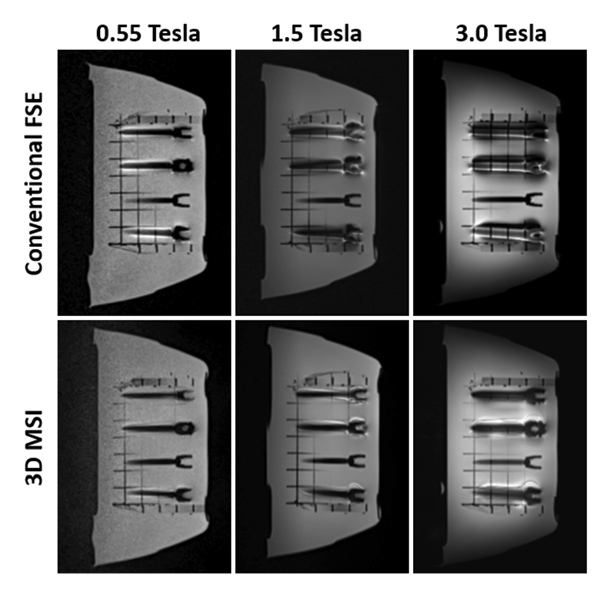Advanced Imaging of Peripheral Pain Generators
 Imaging at 0.55, 1.5, and 3.0 Tesla. The main magnetic field strength of clinical MRI scanners has shifted from 1.5 Tesla to 3 Tesla over the past decades. This is because higher field strength offers a higher signal-to-noise ratio, which, in turn, enables higher spatial-resolution imaging. Contrary to this trend, a new 0.55 Tesla whole-body MRI scanner was recently released. The primary motivation for this mid-field MRI scanner is to improve the accessibility to MRI with significantly reduced initial and maintenance costs.
Imaging at 0.55, 1.5, and 3.0 Tesla. The main magnetic field strength of clinical MRI scanners has shifted from 1.5 Tesla to 3 Tesla over the past decades. This is because higher field strength offers a higher signal-to-noise ratio, which, in turn, enables higher spatial-resolution imaging. Contrary to this trend, a new 0.55 Tesla whole-body MRI scanner was recently released. The primary motivation for this mid-field MRI scanner is to improve the accessibility to MRI with significantly reduced initial and maintenance costs.
Aside from the cost-effectiveness, the 0.55 Tesla scanner offers a unique advantage over the 1.5 Tesla and 3 Tesla scanners: substantially reduced magnetic field inhomogeneity. This is particularly useful for MRI of patients with metallic implants. Metal in the human body perturbs the applied magnetic field proportionally to the main field strength of the MRI scanner. The resulting main field inhomogeneity causes image distortion artifacts, which are much more severe in 3 or 1.5 Tesla MRI than in 0.55 Tesla MRI.
Approximately one million joint arthroplasties and 400,000 spinal fusions are performed in the United States annually. The number of cases is estimated to double by 2030 with the steady increase of the aging population and younger patients. Unfortunately, 10 percent to 30 percent of patients suffer from symptomatic postoperative complications. MRI can enable the early detection of periprosthetic tissue damage if the prohibitive imaging artifacts near implants can be corrected. The substantial metal artifact reduction at 0.55 Tesla MRI provides a new opportunity to develop the next-generation MRI examination of postoperative complications.
- 116 million adults in the U.S. adults suffer from common chronic pain conditions, more than the number affected by heart disease, diabetes, and cancer combined.
- The cost of pain management is approximately $635 billion for people who suffer from these chronic conditions.
- Treatments are only effective 30 percent of the time, partly due to our inability to pinpoint pain generators.

